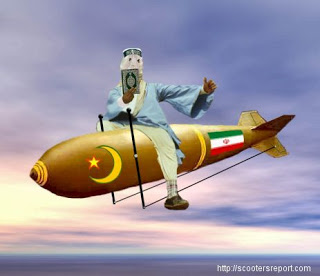Secret document exposes Iran’s nuclear trigger

From the London Times:
Confidential intelligence documents obtained by The Times show that Iran is working on testing a key final component of a nuclear bomb.
The notes, from Iran’s most sensitive military nuclear project, describe a four-year plan to test a neutron initiator, the component of a nuclear bomb that triggers an explosion. Foreign intelligence agencies date them to early 2007, four years after Iran was thought to have suspended its weapons programme.
An Asian intelligence source last week confirmed to The Times that his country also believed that weapons work was being carried out as recently as 2007 — specifically, work on a neutron initiator.
The technical document describes the use of a neutron source, uranium deuteride, which independent experts confirm has no possible civilian or military use other than in a nuclear weapon. Uranium deuteride is the material used in Pakistan’s bomb, from where Iran obtained its blueprint.
“Although Iran might claim that this work is for civil purposes, there is no civil application,” said David Albright, a physicist and president of the Institute for Science and International Security in Washington, which has analysed hundreds of pages of documents related to the Iranian programme. “This is a very strong indicator of weapons work.”
The documents have been seen by intelligence agencies from several Western countries, including Britain. A senior source at the International Atomic Energy Agency (IAEA) confirmed that they had been passed to the UN’s nuclear watchdog.
A Foreign and Commonwealth Office spokeswoman said yesterday: “We do not comment on intelligence, but our concerns about Iran’s nuclear programme are clear. Obviously this document, if authentic, raises serious questions about Iran’s intentions.”
Responding to The Times’ findings, an Israeli government spokesperson said: “Israel is increasingly concerned about the state of the Iranian nuclear programme and the real intentions that may lie behind it.”
The Times had the documents, which were originally written in Farsi, translated into English and had the translation separately verified by two Farsi speakers. While much of the language is technical, it is clear that the Iranians are intent on concealing their nuclear military work behind legitimate civilian research.
The fallout could be explosive, especially in Washington, where it is likely to invite questions about President Obama’s groundbreaking outreach to Iran. The papers provide the first evidence which suggests that Iran has pursued weapons studies after 2003 and may actively be doing so today — if the four-year plan continued as envisaged.
The documents detail a plan for tests to determine whether the device works — without detonating an explosion leaving traces of uranium detectable by the outside world. If such traces were found, they would be taken as irreversible evidence of Iran’s intention to become a nuclear-armed power.
Mr Fitzpatrick said: “Is this the smoking gun? That’s the question people should be asking. It looks like the smoking gun. This is smoking uranium.”
- Iran Hiding The Evidence
Fox: Iran reportedly cleaning up nuclear work VIENNA – Satellite images of an Iranian military facility appear to show trucks and earth-moving vehicles at the site, indicating an attempted cleanup radioactive traces possibly left by tests of a nuclear-weapon...
-
Guardian: Iran's acceleration of its nuclear programme angers the west Tehran's claim that tripling its uranium enrichment speed will help develop cancer treatments is dismissed as 'a provocation' Western capitals have reacted angrily...
- "i Told You So" Just Doesn't Seem To Be Pleasing
IHT: Iran said to have enough nuclear fuel for one weapon Iran has now produced roughly enough nuclear material to make, with added purification, a single atom bomb, according to nuclear experts analyzing the latest report from global atomic...
- It's Time To Withdraw The Nie
From Commentary Magazine: The November National Intelligence Estimate on Iran declared flatly in its opening sentence that ‘We judge with high confidence that in fall 2003, Tehran halted its nuclear-weapons program.” This was remarkably deceptive....
- With The Logical Force Of The Ditzy, And Armed Might Of The Grand Duchy Of Fenwick
In an admission of the international community’s failure to hold back Iran’s nuclear ambitions, the document – compiled by the staff of Javier Solana, EU foreign policy chief – says the atomic programme has been delayed...
